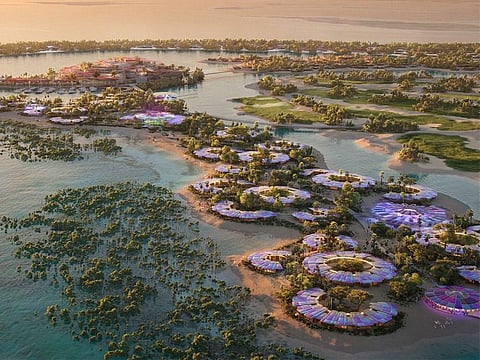Saudi Arabia’s Red Sea project will show development and environment can be a good mix
Less than 1% of 28,000 sq km will be built, and future tourists kept to 1m a year

Dubai: Build anything remotely complex, and it’s a given that environmental and ecological factors come into play at each point of the project lifecycle. Then think about Saudi Arabia’s ‘giga-tourism’ developments, and the scale of complexity becomes something never attempted before.
Because these ventures are not about finding adequate and ideal locations on greenfield sites. Saudi Arabia is attempting to marry multiple elements into those tourism ambitions, using the topography – desert, mountains and islands - and the elements – in the form of extensive shorelines.
The Red Sea Project describes in fine detail what Saudi Arabia seeks to achieve in terms of build scale. Dr. Omar Al-Attas, Head of Environmental Sustainability at TRSDC, talks how all of that can be done – and with a minimal impact on the wider surroundings.
The Red Sea Project extends to more than a decade of build-up. Doesn’t that add to the complexity of protecting the site’s ecology and environment?
We are delivering the world’s most ambitious ‘regenerative tourism destination’ that places the environment at the center of all planning. This means never compromising on our sustainability standards, no matter how complex or challenging, and calling ourselves to account at every stage of the development.
This is where our standing as a data and science-driven company comes into play. Regularly measuring progress against our targets for environmental protection - and enhancement - allows for an unprecedented level of insight into any potential impacts on the surrounding area. And the opportunities we must capitalize on to optimize our conservation benefits.
This ambition first unfolded with an extensive Marine Spatial Planning simulation that informed our initial destination planning. It continues with the largest-ever environmental survey undertaken by any development company.
Both initiatives helped us comprehensively analyze the fascinating wildlife that inhabit over 200 kilometers of the Red Sea coastline that sit within our project site – including a large number of endangered species that call the area their home and must be protected.
What will be The Red Sea Project’s actual built up area eventually? And the land mass available for development?
Despite an archipelago of more than 90 islands, we are leaving 75 per cent of The Red Sea Project untouched and developing less than 1 per cent of the entire destination’s total area of 28,000 square kilometers. In addition, nine islands have been designated as special conservation zones.
Because the build-up will be done in phases, how do you intend to minimize the impact on the unique aspects of the wider environment?
Our goal is to not only minimize any negative impacts but to also leave the destination in a healthier place than before. We strive to achieve the next step in sustainable tourism, by going beyond just preventing harm to encouraging environmental regeneration and restoration.
I hope our approach can encourage others to also avoid and even reverse the effects of ‘extractive tourism’ – a term that recently found its way in the lexicon of the travel industry to draw attention to tourism’s increasing role in extracting value away from the environment and contributing to the climate crisis.
Our key aspiration is to become the world’s largest destination run solely on 100 per cent renewable energy and deliver a 30 per cent net conservation benefit by 2040. Rather than stripping our site of its wealth of natural resources, we are enhancing wildlife ecosystems.
We are establishing one of the largest marine-protected areas in the world as well as the region’s largest landscape nursery with the capacity to grow nearly 25 million plants.
We are also investigating suitable carbon sequestration techniques through a Marine Microalgae Production Farm, while expanding seagrass, mangrove habitats, and mechanical trees to reduce our overall carbon footprint.
We have factored ‘over-tourism’ into every facet of our destination planning and, as such, are restricting our annual visitors to one million.
Would any of the plans include transposing some of the rarer breeds of flora and fauna to a like-for-like place? Or would that too cost prohibitive?
We are already maintaining ecological balance and protecting flora and fauna in our one million-square meter landscape nursery – one of the largest in the region. This will produce more than 25 million plants for landscaping across our destination by 2030, including predominantly native species that have the ability to fully adapt to the climate conditions around the destination.
We are also exploring additional desert-dwelling species within this space, once we have ensured that any introduced species will flourish alongside the local flora and fauna.
Some amount of degradation will inevitability happen to the environment with any development. Is there a base level that developers should not cross?
Environmental degradation at any level can and should be avoided. The industry often sees this as an unsurpassable challenge in sustainable development. But for us, making optimal use of our natural resources constitutes a key element in our regenerative tourism strategy.
We have always believed that the best way to protect and enhance nature is by becoming part of it. Our researchers and partner organizations prove every day that enhancement – and not exploitation – of natural resources is what truly drives economic progress.
Will all of the future builds by TRSDC hew to sustainable ways?
Absolutely. We envision The Red Sea Project as a catalyst in the global transition to regeneration. Our sustainability targets are ultimately aligned with Saudi Arabia’s commitments towards net-zero greenhouse gas emissions by 2060, as well all 17 UN SDGs.
Sign up for the Daily Briefing
Get the latest news and updates straight to your inbox







